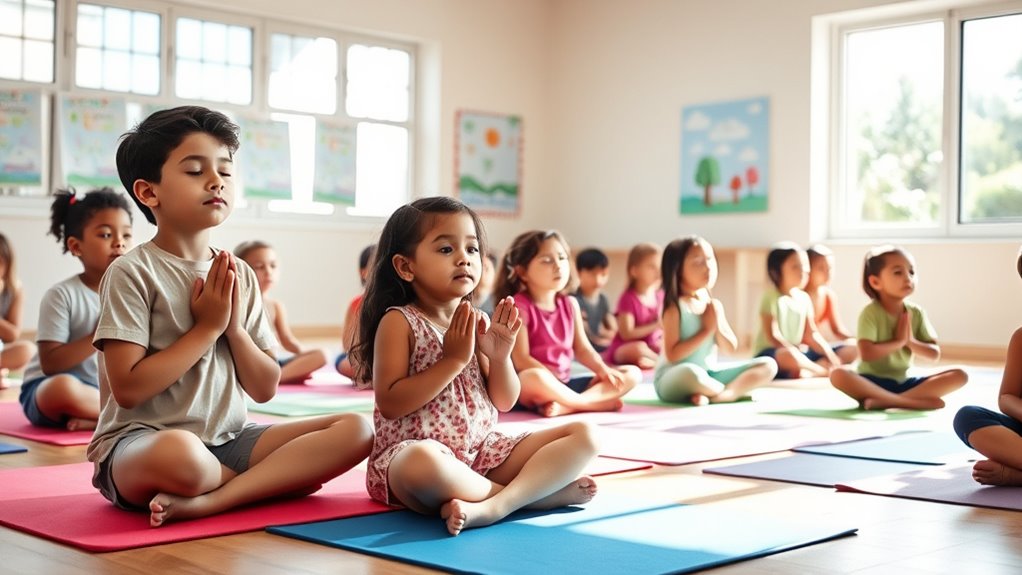To encourage kids to practice yoga and breathing exercises, make it fun and engaging by using playful poses, stories, and creative imagery like animals or superheroes. Keep sessions short, about 10-15 minutes, and focus on making it feel like a game rather than a chore. Praise their efforts and stay consistent to help develop healthy habits. If you keep exploring different ideas, you’ll discover even more ways to support your child’s well-being.
Key Takeaways
- Make sessions fun by incorporating games, storytelling, and imaginative poses to engage children’s interest.
- Use simple, age-appropriate techniques like balloon blowing or flower smelling to introduce breathing exercises.
- Establish consistent routines and short practice sessions to build habits and maintain motivation.
- Praise efforts and focus on enjoyment rather than perfection to foster positive associations with practice.
- Highlight the benefits of yoga and breathing for stress relief, focus, and emotional resilience to encourage participation.

Introducing kids to yoga and breathing exercises can be a powerful way to help them manage stress, improve focus, and build healthy habits early on. When you introduce mindfulness techniques and fun yoga poses, you make the experience engaging and accessible, encouraging kids to develop a positive relationship with their bodies and minds. Kids often learn best through play, so incorporating playful elements into yoga sessions keeps their interest high and makes the practice feel like a game rather than a chore.
Start by demonstrating simple mindfulness techniques that help children become aware of their breathing and surroundings. For example, guiding them to take slow, deep breaths can help calm their minds and reduce anxiety. You can turn this into a game by asking them to imagine blowing up a balloon or smelling a flower with each inhale, then pretending to blow out a candle or blow away clouds with each exhale. These small activities teach children how to control their breath and stay present in the moment. When kids learn to recognize their feelings and body cues, they gain tools to handle stress better and stay focused during school or other activities.
Practice simple breathing games like blowing up balloons or smelling flowers to help kids stay calm and present.
Next, introduce fun yoga poses that are easy for children to do and that spark their imagination. Poses like the “cat-cow,” “cobra,” or “tree” can be made playful by turning them into animals or nature scenes. For example, you might ask them to imagine they’re a tall, sturdy tree with roots deep in the ground or a graceful cat stretching after a long nap. Keep the instructions simple and encourage creativity, so they feel free to explore their movements. Incorporate storytelling into the poses, like pretending to be a superhero stretching their powers or a butterfly fluttering its wings. This approach not only makes yoga more enjoyable but also helps improve their flexibility, balance, and coordination. Additionally, understanding the benefits of sleep and mental health underscores how regular practice can support their emotional well-being and resilience.
Consistency is key when encouraging kids to practice yoga and breathing exercises. Short sessions of 10 to 15 minutes, a few times a week, work well for maintaining their interest and establishing a routine. Praise their efforts and focus on the fun aspect rather than perfection. As they become more comfortable with mindfulness techniques and fun yoga poses, they’ll naturally start to use these skills during stressful moments or when they need a break. By making yoga and breathing exercises an enjoyable part of their daily life, you’re helping them develop lifelong habits that promote emotional resilience, physical health, and mental clarity.
Frequently Asked Questions
What Are the Best Times of Day for Kids to Practice Yoga?
You should encourage kids to practice yoga during their morning routine and evening wind down. Morning sessions help energize them for the day ahead, promoting focus and positivity. Evening practices, on the other hand, help them relax and unwind before bed, improving sleep quality. Keep sessions short and engaging, making these times enjoyable parts of their daily routine, so yoga becomes a natural, calming habit.
How Do I Make Yoga Sessions Fun for Children?
Think of yoga as a playful adventure where every pose is a new discovery. You can make sessions fun by turning yoga into games, like pretending to be trees or animals, and encouraging kids to create their own creative poses. Using bright mats and fun music also helps. When kids see yoga as a game, they stay engaged and excited to explore new movements, making learning both fun and beneficial.
Are There Any Safety Concerns for Kids Doing Yoga?
Yes, there are safety concerns for kids doing yoga. You should follow safety precautions like ensuring proper warm-up and avoiding poses that strain growing joints or muscles. Supervision guidelines are essential; always watch closely to correct posture and prevent injuries. Make sure the environment is safe, with enough space and no sharp objects. By staying attentive and guiding kids appropriately, you can help them enjoy yoga safely and benefitsfully.
Can Yoga Help With Kids’ Behavioral Issues?
Yes, yoga can help with kids’ behavioral issues by enhancing mindfulness benefits and promoting emotional regulation. When you encourage your child to practice yoga, they learn to stay present and manage their emotions better. This can lead to improved focus, reduced anxiety, and fewer tantrums. Regular yoga sessions teach kids to recognize their feelings and respond calmly, ultimately supporting their emotional and behavioral development in a positive way.
How Do I Introduce Breathing Exercises to Reluctant Children?
You can introduce breathing exercises to reluctant children by making it fun with playful techniques like blowing bubbles or pretending to blow out candles. Start with simple mindful breathing, encouraging them to focus on their breath and feel calm. Use stories or games to keep them engaged, and praise their efforts. Gradually, they’ll enjoy the calming effects, making mindfulness a natural part of their routine.
Conclusion
By encouraging your kids to practice yoga and breathing exercises, you help them build strength, focus, and relaxation skills that last a lifetime. Did you know that children who regularly practice mindfulness and yoga report a 30% decrease in stress levels? Imagine your child feeling calmer and more centered each day, ready to face challenges with confidence. Just a few minutes daily can make a big difference in their well-being and happiness.









